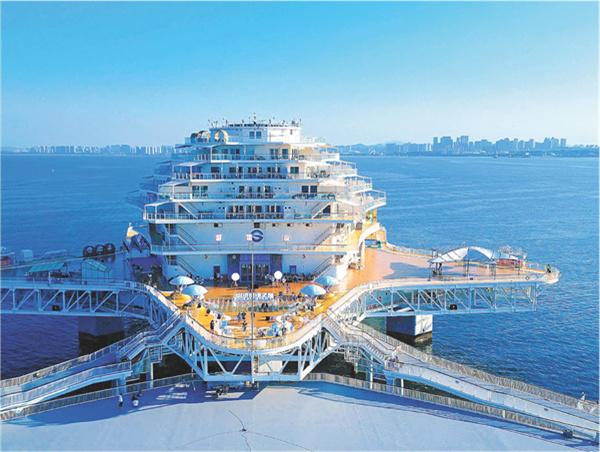Yantai at Sea: Where Possibilities Run Deep

The marine ranch complex “Ocean Harvest No.1” combines functions such as fisheries farming, maritime sightseeing, and recreational fishing, pioneering a new model for the development of equipment-based and leisure-oriented marine ranching. (File photo)
By Cong Chunlong, Reporter of Dazhong Daily
Yantai’s land area spans 13,900 square kilometers, shaped like a jellyfish. But beyond its shores lies another “New Yantai” on the sea.
Its jurisdictional waters cover 11,600 square kilometers, accounting for a quarter of Shandong Province’s total area, with a coastline stretching 1,071 kilometers, nearly one-third of the provincial total. It boasts 230 islands, making up two-fifths of the province’s total, with a total island area of 68 square kilometers, and bay waters spanning approximately 3,600 square kilometers. Home to over 200 offshore marine species, with more than 100 of them commercially valuable, Yantai is a key national fishing zone and a major production area for high-quality aquatic products, ideal for farming sea cucumber, abalone, scallops, prawns, premium marine fish, and kelp.
The ocean is a strategic frontier for Yantai’s high-quality development, representing its greatest potential, most significant advantage, and strongest engine for growth. Yantai has set a goal to become a central city in the Bohai Rim region by 2035 and has positioned itself as a demonstration city for green, low-carbon, high-quality development. The city is prioritizing the growth and optimization of its marine economy, vigorously implementing a comprehensive marine development strategy and coordinating the development of industries such as maritime transport, marine ranching, offshore wind power, offshore photovoltaics, and sea-based rocket launches, which aim to accelerate efforts to build a modern marine economy hub. In 2024, Yantai’s gross ocean product exceeded 280 billion yuan, accounting for 26% of its GDP.
Yantai at Sea continues to polish its golden reputation as the “Capital of Deep-Sea Aquaculture”. The city has expanded its aquaculture area to 3.5 million mu (approximately 233,333 hectares) and gained approval for China’s first offshore economic development zone—the Changdao “Blue Granary” Marine Economic Zone. It is deeply implementing the “Hundred Cages Plan” for marine ranching, with 34 deep-sea aquaculture facilities built. Designated as one of the first pilot cities in the province for improving and upgrading the entire deep-sea fishing industry chain, it launched the “Ten-Thousand-Ton Salmon Plan”, achieving success with a land-to-sea relay salmon farming model.
Yantai at Sea has been approved as a port-type national logistics hub. It has developed ten major port areas, including Zhifu Bay Port Area, West Port Area, and Longkou Port Area, with 243 productive berths and 93 domestic and international shipping routes, connecting to over 150 ports in more than 100 countries and regions. Its cargo throughput exceeds 500 million tons, ranking it among the world’s top ten coastal ports.
As an “International Garden City” gold award winner, Yantai at Sea has strived to build three national tourist resorts and 23 AAAA-level or higher scenic spots. It has launched more than 10 maritime tour routes, including night cruises in Zhifu Bay and the “Search for Immortals” route linking Changdao and Lyushun, hosting over 98 million domestic tourists.
Yantai at Sea is witnessing the vigorous development of three 100-billion-yuan-level industrial parks: Yulong Petrochemical Industrial Park, Yantai Chemical Industrial Park, and Wanhua New Materials Low-Carbon Industrial Park. The city’s shipbuilding and marine engineering equipment cluster has been chosen as a national advanced manufacturing cluster. Vessels like the “Blue Whale No.1” are venturing into deep-sea operations. Luye Pharma won approval for Lurbinectedin, an innovative marine-derived anti-cancer drug, while DC Pharma became the world’s largest supplier of chondroitin sulfate raw materials from marine fish.
Yantai at Sea generated China’s first kilowatt-hour of electricity from large-scale fixed-pile offshore photovoltaics, along with Shandong’s first kilowatt-hour of nuclear power and first kilowatt-hour of offshore wind power. The Oriental Spaceport, China’s only commercial maritime launch base, is expanding rapidly. Since 2019, it has supported 17 sea-based launch missions, sending 104 satellites into orbit.
Yantai at Sea introduced the nation’s first “Seagrass Bed and Algae Field Carbon Sink Loan” and Shandong’s first “Marine Ranch IoT Loan.” Yantai is developing the Changdao International Zero-Carbon Island and has initiated the establishment of the International Zero-Carbon Island Cooperation Organization. During the 29th UN Climate Change Conference, it successfully hosted the launch event for the “International Zero-Carbon Island Cooperation Initiative.”
Yantai at Sea holds unlimited possibilities. The city continues to expand and strengthen its marine industries, striving to build a modern marine economy hub. It aims to achieve a gross ocean product of over 300 billion yuan by 2025 and exceed 400 billion yuan by the end of the 16th Five-Year Plan period.
From a “blue granary” to an international zero-carbon island, from a clean energy hub in the northern coastal region to a world-class commercial aerospace maritime launch base, from a global marine equipment manufacturer to a world-class green petrochemical city, and from a port-type national logistics hub to a top domestic marine culture and tourism destination, a new Yantai at sea is rapidly rising.

